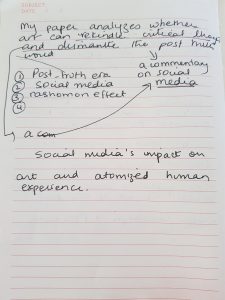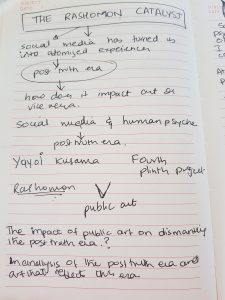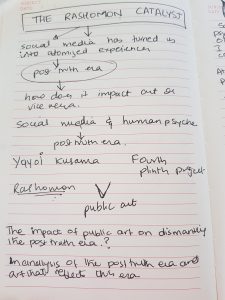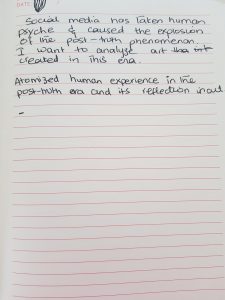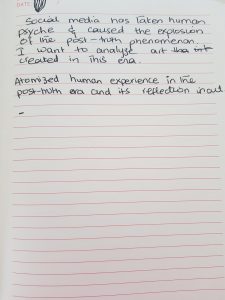The blog seems to have been neglected of late, but that’s actually not true. In an earlier lecture Jonathan mentioned that this reflective practice could happen in several ways. Since my time is currently taken up completely by my job, working on the Iridescent Alloys and my research paper, I haven’t been able to type out coherent thoughts into blogposts as often as I like. But I have been creating a reflective record in other ways, I have been noting things down in notebooks, scribbling and doodling ideas, and of course keeping my visual journal, all of which I will upload here in due course. There are also a lot of blogposts written and saved as drafts that need the pictures added to them so I can officially publish them.
But right now, the most pressing concern for me is the upcoming deadline of the research paper. I know Jonathan said grades are not important but I feel like I want to do this right, and that feeling sometimes overwhelms me. Am I competitive? probably. But more so, this MA is very integral to me and I genuinely want to do a dedicated job that turns out well!
A few weeks ago we had a tutorial with Gareth about our research paper. At that time I was still in the voracious reading mode, and all I had to show was this:
Gareth and I discussed a lot of things but what left the most impression on me was this thing he said in an uncertain tone– your topic has changed so drastically since the first time….
Perhaps I wasn’t able to explain myself well enough, but I feel like the topic I am currently working with is a very logical evolution of the idea I initially had.
I began with this idea of ‘what is art’. I researched theories of what artists and movements before me had believed. The question I asked in a tutorial with Jonathan was, who determines what art is, the audience or the intention of the artist. The truth is, this question was too vast to be answered in a 4000 word paper and Jonathan asked me to think about my motivations; i.e. WHY am I interested in this question in the first place. So I did. And what stood out to me was the freedom of social media as a platform and the critique, feedback and fame you could achieve through it. Artists have gained celebrity status through social media. Artists have also become embroiled in a love-hate relationship of measuring their own self-worth through likes. Cliche as it sounds, social media is a double edge sword. I also knew wanted to explore public art as I said in the first tutorial with Gareth, and social media essentially WAS public art in this day and age.
In previous blogposts I have mentioned what I read and researched to arrive at many many different and interesting books, ideas and topics. But none of them seemed to capture this essential idea of trying to define the nature of the social media world and what impact it has had on art.
Then I read about the concept of post-truth and here was something interesting, a way that social media and the cognitive biases of humans had developed this era of digimodernism. So I delved deeper into it and I felt like George Orwell had a pretty good handle on a satirical aspect of post-truth even when he wrote ‘1984’ in 1949. So this is the topic I thought would suit:
Public Art in the Post-Truth Era: A commentary on social media through the prism of Lee McIntyre’s book ‘Post-Truth’ as well as the allegories in George Orwell’s ‘1984’.
After the tutorial, we had an eye opening session with Jonathan which I will probably discuss in another blogpost as well and that set me reflecting again. Ben sent me his paper to read through (amazing btw!) and I also happened to visit robin’s blog. Robin’s reflections on his tutorial really gave me some good pointers (love the way that guy writes and thinks!). One of the things I noticed in both Robin and Ben’s research paper was that they were aiming for their titles to be:
- An accurate representation of the tone and content of the paper
- Concise and without any unnecessary words
By that time, I had arrived at this second draft of the paper:
Research paper brainstorming part 2
I was quite proud of it, but after the Skype session with Jonathan where he mentioned the importance of balancing references with analysis, I began to see that it needed revision as much as my title did. So I revisited my title and my abstract and really thought about what I was trying to say.
After all this random note taking, I came to the conclusion that the main thing I was interested in exploring was the nature of social media discourse and its impact on art. By nature I mean the way in which individuals can voice their thoughts in isolation of everything around them, yet at the same time, it can be potentially viewed by the whole world. Every word is easier to put out there and has more consequence. That is where the word post-truth came in. In my paper I could critically analyze the works of certain artists to comment on this social media phenomenon. so here is the final succinct title I drafted:
Public Art in the Post Truth Era
Atomized human experience and its reflection in art
So you see, this is a logical derivation from my original question of ‘what is art’. Since that was too vast a subject, I narrowed it down further and further till the question has now become, ‘who we are and how we make our art in the digital landscape’.
